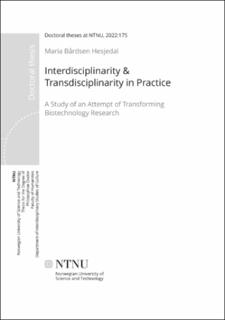| dc.contributor.advisor | Åm, Heidrun | |
| dc.contributor.advisor | Sørensen, Knut Holtan | |
| dc.contributor.author | Hesjedal, Maria Bårdsen | |
| dc.date.accessioned | 2022-05-30T08:06:42Z | |
| dc.date.available | 2022-05-30T08:06:42Z | |
| dc.date.issued | 2022 | |
| dc.identifier.isbn | 978-82-326-6688-1 | |
| dc.identifier.issn | 2703-8084 | |
| dc.identifier.uri | https://hdl.handle.net/11250/2996664 | |
| dc.description.abstract | Sammendrag:
Denne avhandlingen tar utgangspunkt i spørsmålet om hvordan tverrfaglighet i vitenskap oppnås i praksis. Jeg har studert dette i konteksten norsk bioteknologi, og har utført forskningsarbeidet i Senter for Digitalt Liv Norge (DLN), et nasjonalt senter for bioteknologisk forskning. DLN er resultatet av et strategisk initiativ fra Norges Forskningsråd for å transformere norsk bioteknologi gjennom transdisiplinaritet, og utgjør dermed et godt utgangspunkt for å kunne studere denne problematikken. Forskningen er hovedsakelig basert på etnografisk feltarbeid og semistrukturerte intervjuer i DLN.
Fire forskningsartikler, som hver tar for seg ulike aspekter ved tverrfaglighet i DLN, danner grunnlaget for avhandlingen. Artiklene analyserer hvordan forskere i et transdisiplinært forskningssenter forstår den forskningspolitiske ideen om transdisiplinaritet, hvordan tre ulike bioteknologiske forskningsprosjekter gjør tverrfaglighet i praksis, hvordan forskere sosialiseres inn i et tverrfaglig tankesett gjennom dannelsen av sted (placemaking), samt et doktorgradskurs som forsøker å endre yngre bioteknologiforskere sin forståelse av forholdet mellom samfunn og vitenskap.
For å svare på avhandlingens forskingsspørsmål analyseres de fire artiklene sammen gjennom et teoretisk rammeverk bestående av praksisteori (Shove et al. 2012), kombinert med Knorr Cetinas ‘epistemiske maskinerier’ (1999). I kryssanalysen identifiserer jeg et sett med kjerne- og støttepraksiser som jeg hevder er svært innflytelsesrike i tverrfaglige samarbeid. Jeg argumenterer for at kjerne- og støttepraksisene til sammen utgjør og skaper komplekse epistemiske maskinerier av tverrfaglig kunnskapsproduksjon som er både avhengig av og formet av lokale forhold.
Summary
This dissertation sets out to answer the question of how disciplinary transgression in science is achieved. I study this in the context of Norwegian biotechnology, having conducted my research within a national centre for biotechnology research, the Centre for Digital Life Norway (DLN). DLN is a product of strategic efforts in the Research Council of Norway to transform Norwegian biotechnology through transdisciplinarity and therefore offers an interesting avenue to seek answers to the research question. The research in this dissertation is based mainly on ethnographic fieldwork and semi-structured interviews in DLN.
Four research papers, each of which addresses different aspects of disciplinary transgressions in DLN, form the basis of the dissertation. The papers analyses how scientists in a transdisciplinary research centre make sense of the research policy idea of transdisciplinarity, how interdisciplinarity is done in practice in three biotechnology research projects, how biotechnology scientists were socialised into an interdisciplinary mindset by place-making in a multi-sited research centre, and an interdisciplinary PhD course aiming to transform early-careers’ understanding of science-society relations.
The four papers are analyzed together through a theoretical framework of practice theory (Shove et al. 2012), combined with Knorr Cetina’s notion of epistemic machineries (1999) to address the main research question. In the analysis, I identify a set of core and support practices that I argue are highly influential in disciplinary transgression. I argue that the core and support practices together constitute complex epistemic machineries of disciplinary transgressive knowledge production that are dependent on and shaped by local conditions. | en_US |
| dc.language.iso | eng | en_US |
| dc.publisher | NTNU | en_US |
| dc.relation.ispartofseries | Doctoral theses at NTNU;2022:175 | |
| dc.relation.haspart | Paper 1:
Hesjedal, Maria Bårdsen; Åm, Heidrun.
Making sense of transdisciplinarity: Interpreting science policy in a biotechnology centre | en_US |
| dc.relation.haspart | Paper 2:
Hesjedal, Maria Bårdsen; Sørensen, Knut Holtan.
Relying on relay: Flows in interdisciplinary collaborations in biotechnology | en_US |
| dc.relation.haspart | Paper 3:
Hesjedal, Maria Bårdsen.
Socializing scientists into interdisciplinarity by placemaking in a multi-sited research center.
- The final published version is available in
Science, Technology, & Human Values. May 2022.
https://doi.org/10.1177/01622439221100867
This article is distributed under the terms of the Creative Commons Attribution 4.0 License (CC BY 4.0) | en_US |
| dc.relation.haspart | Paper 4: Hesjedal, Maria Bårdsen; Åm, Heidrun; Sørensen, Knut Holtan; Strand, Roger. Transforming Scientists’ Understanding of Science–Society Relations. Stimulating Double‑Loop Learning when Teaching RRI. Science and Engineering Ethics 2020 ;Volum 26. s. 1633-1653 https://doi.org/10.1007/s11948-020-00208-2 This article is licensed under a Creative Commons Attribution 4.0 International License (CC BY 4.0) | en_US |
| dc.title | Interdisciplinarity & Transdisciplinarity in Practice: A Study of an Attempt of Transforming Biotechnology Research | en_US |
| dc.type | Doctoral thesis | en_US |
| dc.subject.nsi | VDP::Humanities: 000::Cultural science: 060 | en_US |

